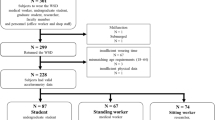Summary
In a total of 23 subjects consisting of 10 clerical and 13 assembly workers in a factory, the pedometer readings during a day of free-living activity were analyzed for the relation with energy expenditure as determined by the simultaneously recorded 24-hour heart rate. The 24-hour energy expenditures in the clerical and assembly workers were 9515 kJ (2274 kcal) and 9698 kJ (2318 kcal) respectively. The whole day readings of the pedometer for all the subjects moderately correlated (r=0.438,p<0.05) with the net energy cost (NEC) as determined by subtracting the sleeping metabolic cost from the energy expenditure (clerical workers:r=0.781,p<0.01; assembly workers:r=0.188,p>0.05). The correlation analysis of the pedometer readings with the NEC in three activity phases in a day (work, commuting and staying at home), showed that the extent of the relationship differed by job types and activity phases. The best correlation was obtained during commuting in both of the job types (clerical workers:r=0.843,p<0.01; assembly workers:r=0.743,p<0.01). During work, a quite strong correlation (r=0.889,p<0.01) was obtained with the clerical workers but not with the assembly workers. No significant correlations were found in the data while the subjects were at home. The capacity of the pedometer to detect the impacts of body movements, and the characteristics of activity, are responsible for the differences in correlation. The limitations of the pedometer suggested in the present study must be taken into account if the device is to be used for measuring physical activity. A particular advantage of the device appears in its use for a sedentary population without regular srenuous exercise or static contractions.
Similar content being viewed by others
References
Acheson KJ, Campbell IT, Edholm OG, Miller DS, Stock MJ (1980) The measurement of daily energy expenditure; An evaluation of some techniques. Am J Clin Nutr 33:1155–1164
Gayle R, Montoye HJ, Philot J (1977) Accuracy of pedometers for measuring distance walked. Res Quart Exercise Sport 48:632–636
Kashiwazaki H, Inaoka T, Suzuki T, Tamada T (1985) Daily energy expenditure of middle-aged Japanese housewives measured by 24-h heart rate and diary. Nutrit Res 5:453–463
Kemper HCG, Verschuur R (1977) Validity and reliability of pedometers in habitual activity research. Eur J Appl Physiol 37:71–82
Montoye HJ, Taylor HL (1984) Measurement of physical activity in population studies: A review. Human Biol 56:195–216
Nishikido N, Kashiwazaki H, Suzuki T (1982) Preschool children's daily activities: direct observations, pedometry or questionnaire. J Human Ergol 11:214–218
Saris WHM, Binkhorst RA (1977a) The use of pedometer studying daily physical activity in man. Part I: reliability of pedometer and actometer. Eur J Appl Physiol 37:219–228
Saris WHM, Binkhorst RA (1977b) The use of pedometer studying daily physical activity in man. Part II: validity of pedometer and actometer measuring the daily physical activity. Eur J Appl Physiol 37:29–235
Stunkard A (1960) A method of studying physical activity in man. Am J Clin Nutr 8:595–601
Washburn R, Chin MK, Montoye HJ (1980) Accuracy of pedometers in walking and running. Res Quart Exercise Sport 51:695–702
Author information
Authors and Affiliations
Rights and permissions
About this article
Cite this article
Kashiwazaki, H., Inaoka, T., Suzuki, T. et al. Correlations of pedometer readings with energy expenditure in workers during free-living daily activities. Europ. J. Appl. Physiol. 54, 585–590 (1986). https://doi.org/10.1007/BF00943345
Accepted:
Issue Date:
DOI: https://doi.org/10.1007/BF00943345




